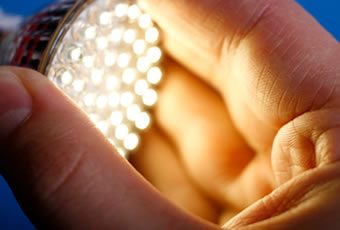
Reduce costs
Improve your carbon footprint
No capital outlay
Create healthier working conditions
Business Energy Efficiency with LED Lighting
An LED lamp is a light-emitting diode. Typically LED lamps have a lifespan and electrical efficiency considerably greater than existing incandescent lamps, and significantly better than fluorescent lighting.
Like incandescent lamps and unlike most fluorescent lamps (e.g. tubes and CFL), LED lights come to full brightness without need for a warm-up time which means that the typical life of fluorescent lighting is reduced by frequently switching it on and off, and due the large insurgent of power required to start the process, and can be damaged if the light fitting is already at a high temperature. So overall running and maintenance costs can be reduced dramatically by simply changing to LED’s.
Initially cost of LED lighting is usually higher to start with, but the degradation is considerably less than conventional lamps and the power consumption is almost 70% less than most existing installations.
With research into organic LED’s (OLED) and polymer LED’s (PLED), cost per lumen and output per device has been improving year in year out, which has brought the many claims of life expectancy to be considerably more accurate and improving the justification of cost savings.
Some LED lamps are made to be directly compatible replacements for incandescent or fluorescent lamps. An LED lamp packaging may show the lumen output, power consumption in watts, colour temperature or description (“warm white”) and sometimes the equivalent wattage of an incandescent lamp of similar luminous output.
LED chips operate using controlled direct current (DC) which means an appropriate power supply is needed, but typically most replacement lamps now come with a DC inverter already installed. LED’s are adversely affected by high temperature, so LED lamps typically include heat elements such as heat sinks and cooling fins which a necessary to prolong the life of the lamp.
A significant difference from other light sources is that the light is more directional, i.e., emitted as a narrower beam. LED lamps can be used for both general and special-purpose lighting both internally and externally. Where coloured lighting is required, LED’s that inherently emit light of a single colour require no energy-absorbing filters, however LED coloured lighting can reduce the typical life expectancy of a standard diode, as the colorant degrades quicker over time. White-light LED lamps have longer life expectancy and higher efficiency (more light for the same electricity) than most other lighting.

